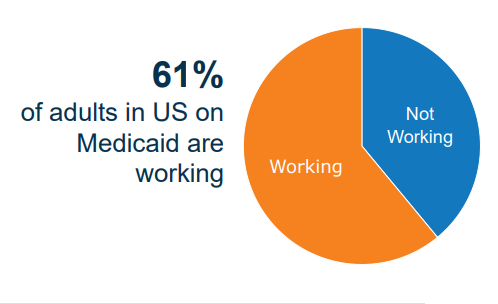Medicaid 101
#Medicaid - A federal-state partnership that is crucial to health care delivery in US, here is a quick primer on what you must know
Reading time: 4 mins

Medicaid one of the largest health insurance programs in the United States -
What is covered under Medicaid?
Acute care (hospital)
Physician visits
Laboratory
Radiology
Home Health
Nursing Facility
EPSDT benefit, for kids< 21 yrs
Prescription Drugs
Dental
Vision
Personal care for frail seniors & people w disabilities
Who is eligible for Medicaid?
All persons must be low-income AND
Children of low-income families (<255% FPL)
Adults - Parents or Childless Adults (<138% FPL)
Pregnant women up to 60 days post-partum (<207% FPL)
Elderly adults and people with disabilities can be dual eligible - Medicare & Medicaid (<74% FPL)

Source: KFF
How many people qualify for Medicaid?
Medicaid enrolled approximately 87 million Americans as of April 2023. (Per KFF, 93.88 million persons in US are enrolled in Medicaid)

Who pays for Medicaid?
Federal and state government pays for Medicaid. Medicaid is administered by states, according to federal requirements.
The Affordable Care Act incentivized states to expand eligibility for persons with income up to 138% FPL ($14,580 annually for an individual in 2023). The initial incentive was 100% federal matching funds to the state. As of 2023, this is now at 90% federal matching funds.
How big is the slice for Medicaid in federal spending?
Medicaid is a major source of funding for hospitals, community health centers, physicians, and nursing homes, as it is one of the largest health insurance providers. It is also a major source of revenue for individual states since the federal government covers 50% of the cost of traditional Medicaid.
Medicaid accounts for 10% of total federal spending on health care for FFY2023 (vs. Medicare at 13%). Read more here
Why is Medicaid in the news?
The Consolidated Appropriations Act of 2023 made continuous enrollment in Medicaid (as it was under Public Health Emergency) a thing of the past. This allows states to disenroll persons and seek a “redetermination,” meaning people have to be reprocessed after they show proof of eligibility for Medicaid. This threatens the continued coverage of services for millions of Americans. Read More here
Final Thoughts
Medicaid is inaccurately referred to (in crude terms) as welfare, handouts, or government aid. Medicaid has been a point of significant political battles, and with those battles come myths and misinformation. Let’s go through some of these myths in style -
MYTH #1: Primary recipients of Medicaid are Black or Hispanic persons.
BUSTED: While 60% of Americans enrolled in Medicaid are persons of color, 40% of Medicaid enrollees are white (KFF). This is an important clarification: as a single group, white persons represent the largest proportion of non-elderly Medicaid enrollees. See below

MYTH #2: The majority of the people on Medicaid do not work.
BUSTED: 61% of Medicaid adults are working (KFF) Read more here

MYTH #3: Medicaid funds are spent on young & healthy people.
BUSTED: While children and adults of low income make up 79% of the enrollees, majority of Medicaid funds are spent on elderly and persons with disabilities. Medicaid covers approximately
1 in 6 adults 19-64 years old,
2 in 5 children
5 in 8 nursing home residents
1 in 6 Medicare beneficiaries
1 in 3 persons with disabilities

Medicaid is an important factor between solvency and medical bankruptcy for households across the country. Review the #s directly above. Since the implementation of the Consolidated Appropriations Act of 2023, at least 3.7 million have lost Medicaid enrollment. Some (or most) are not aware of it. And if they are aware, it is virtually a behemoth task for them to be re-enrolled - the most common reason - paperwork.
Be informed and share this knowledge!


